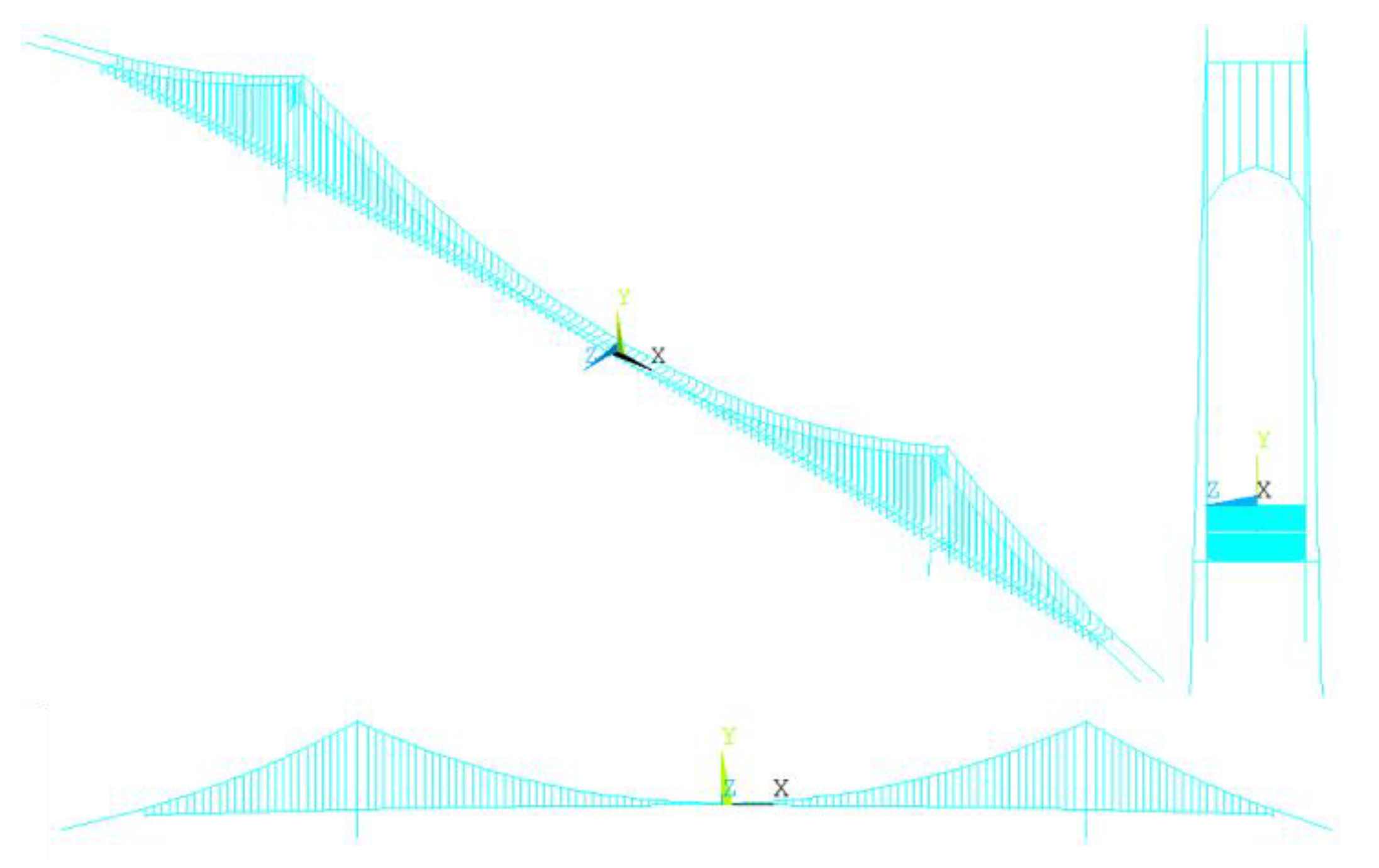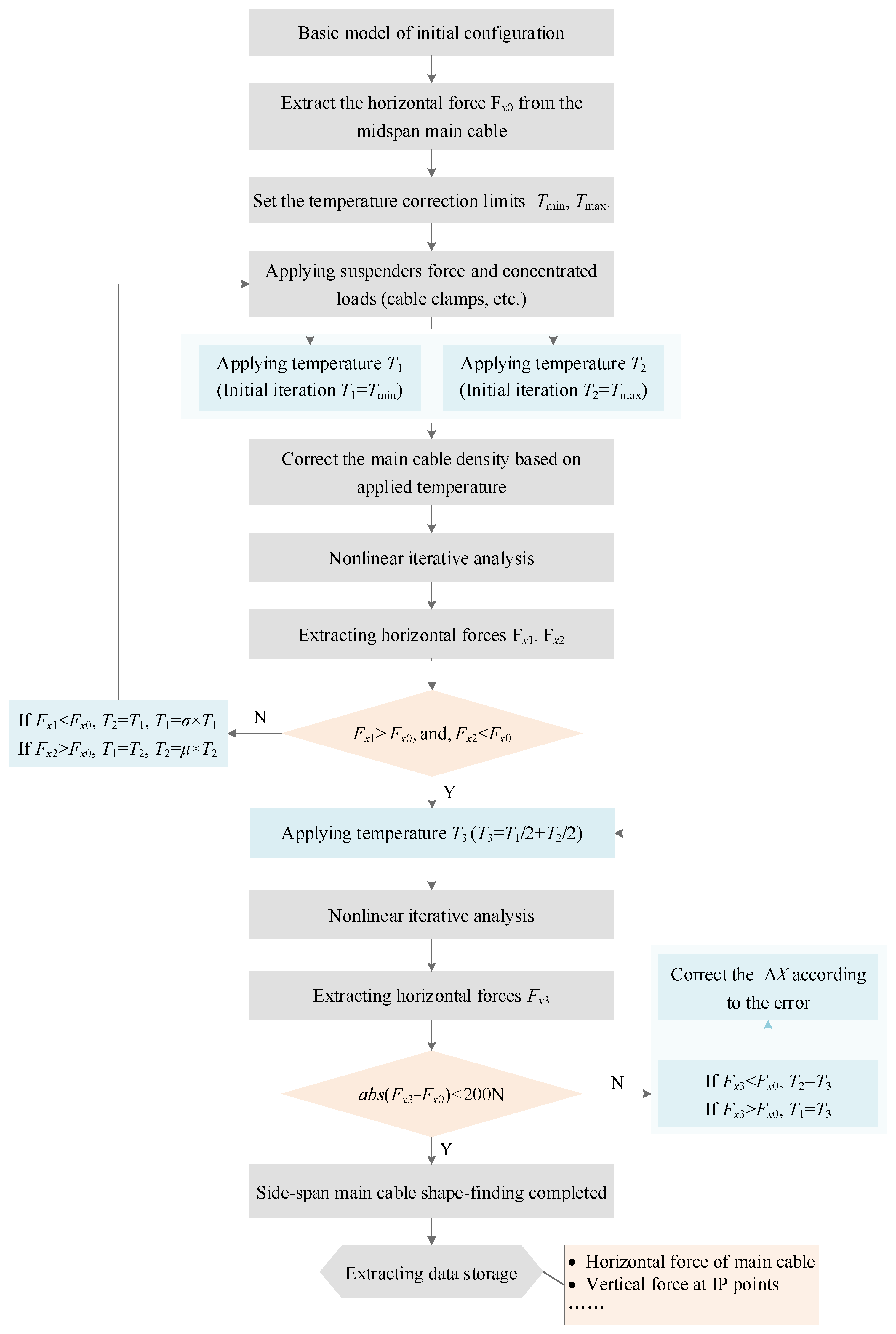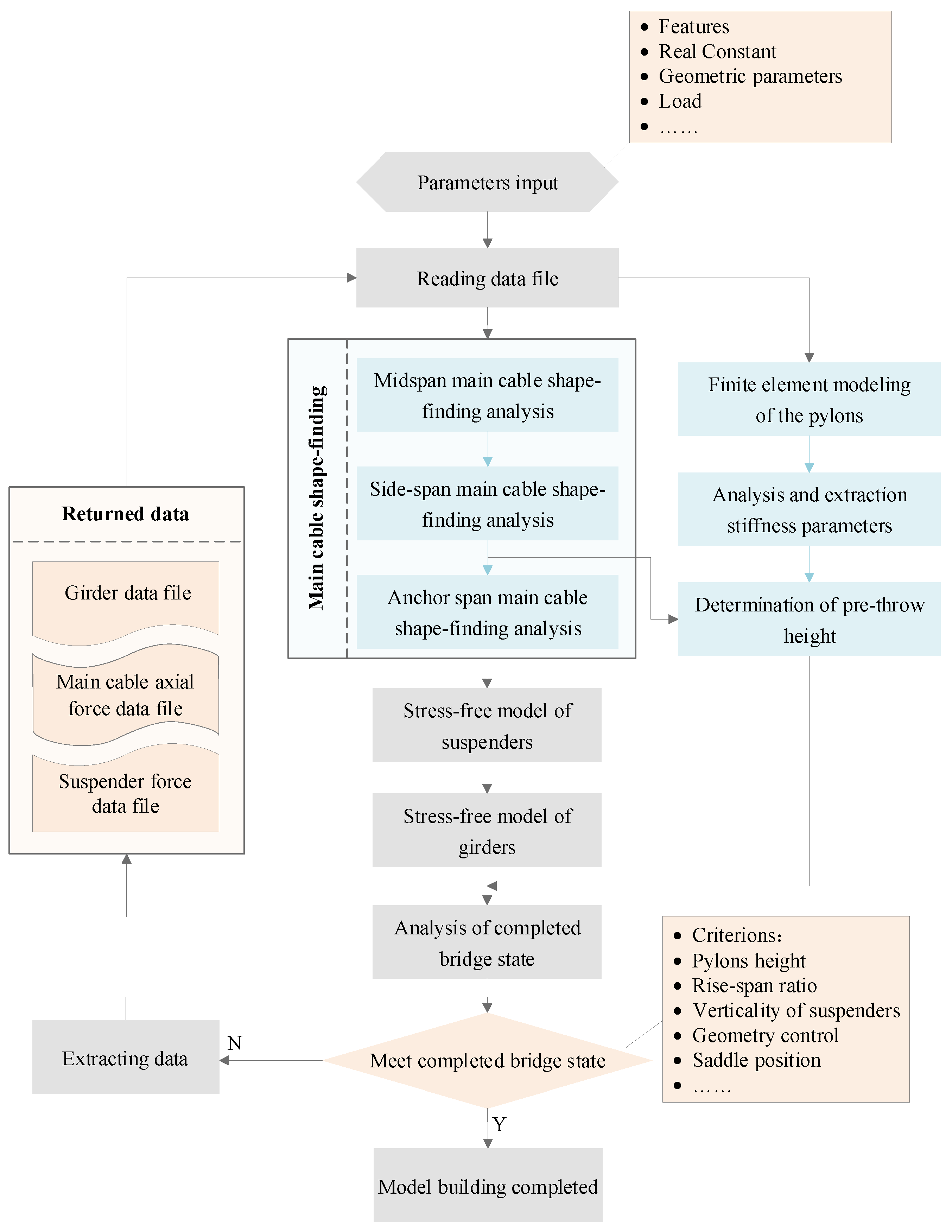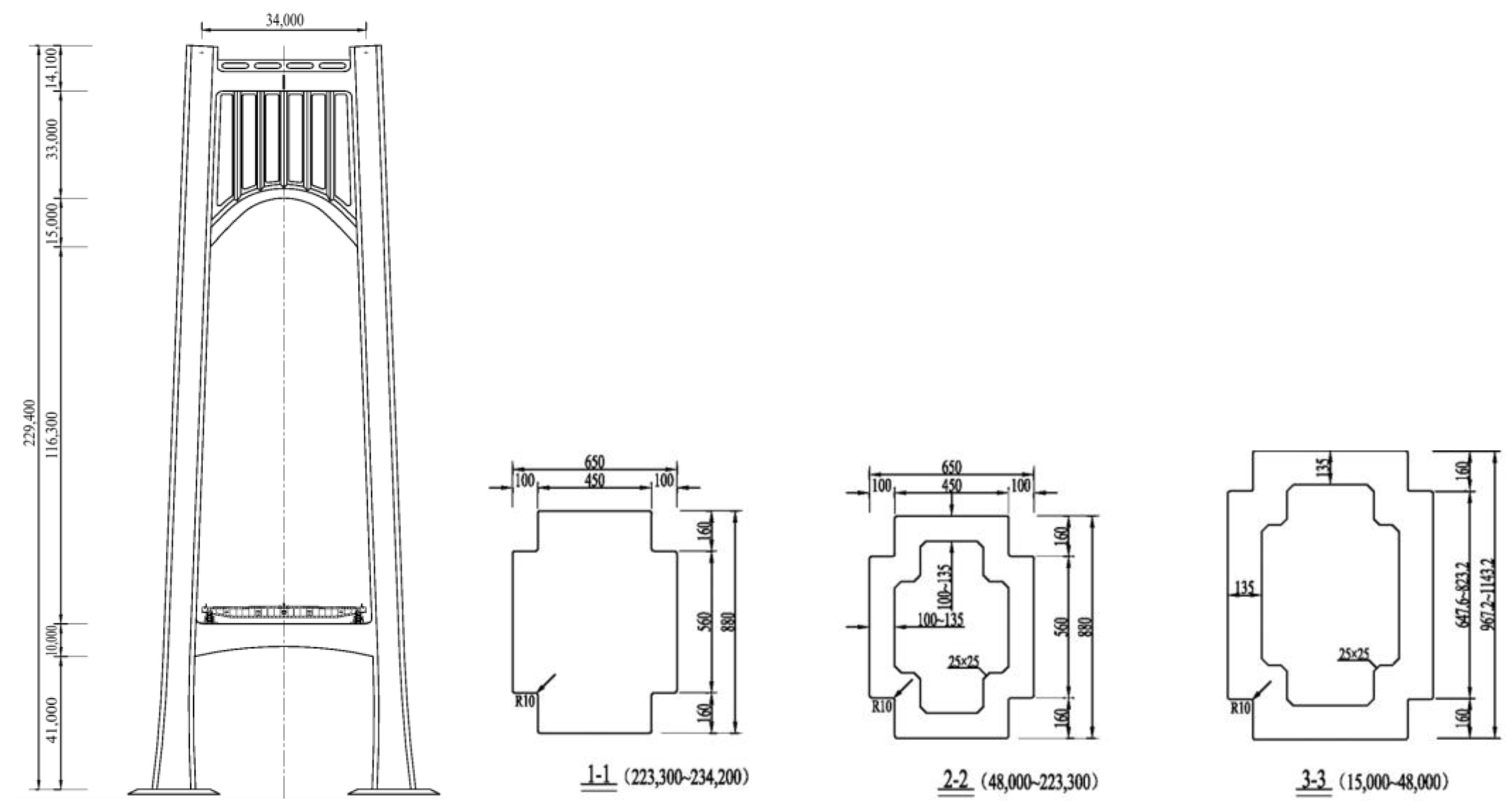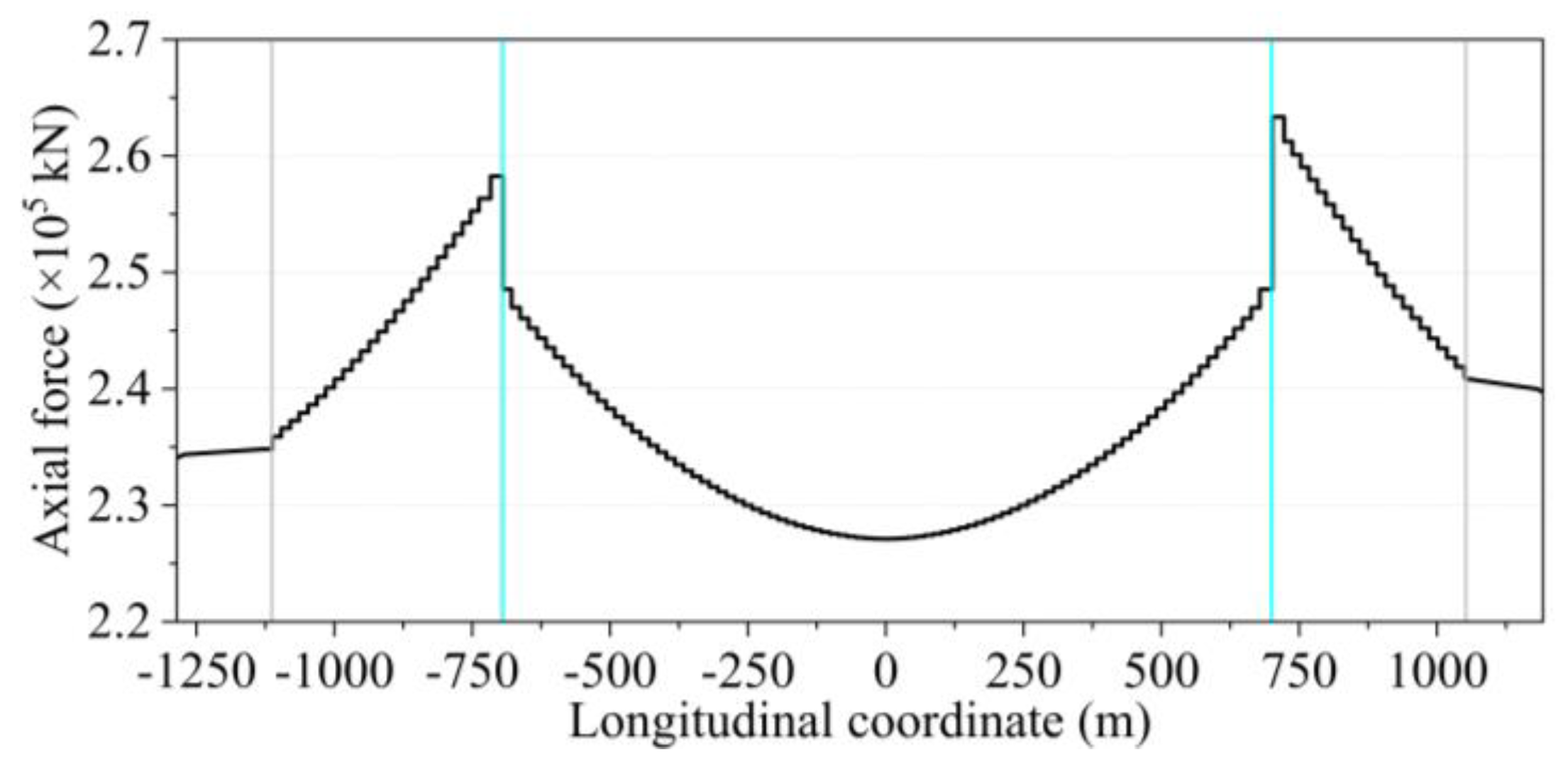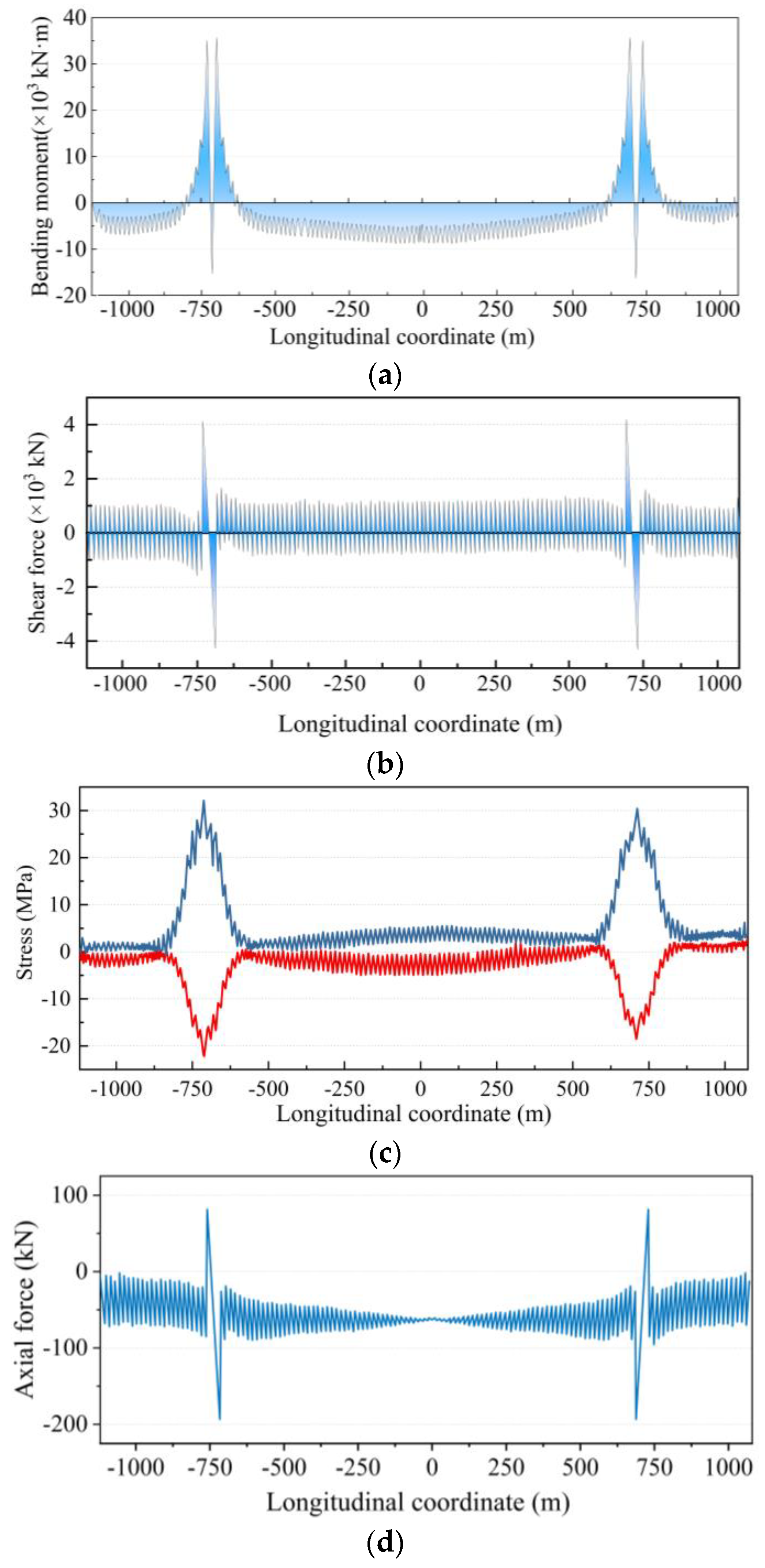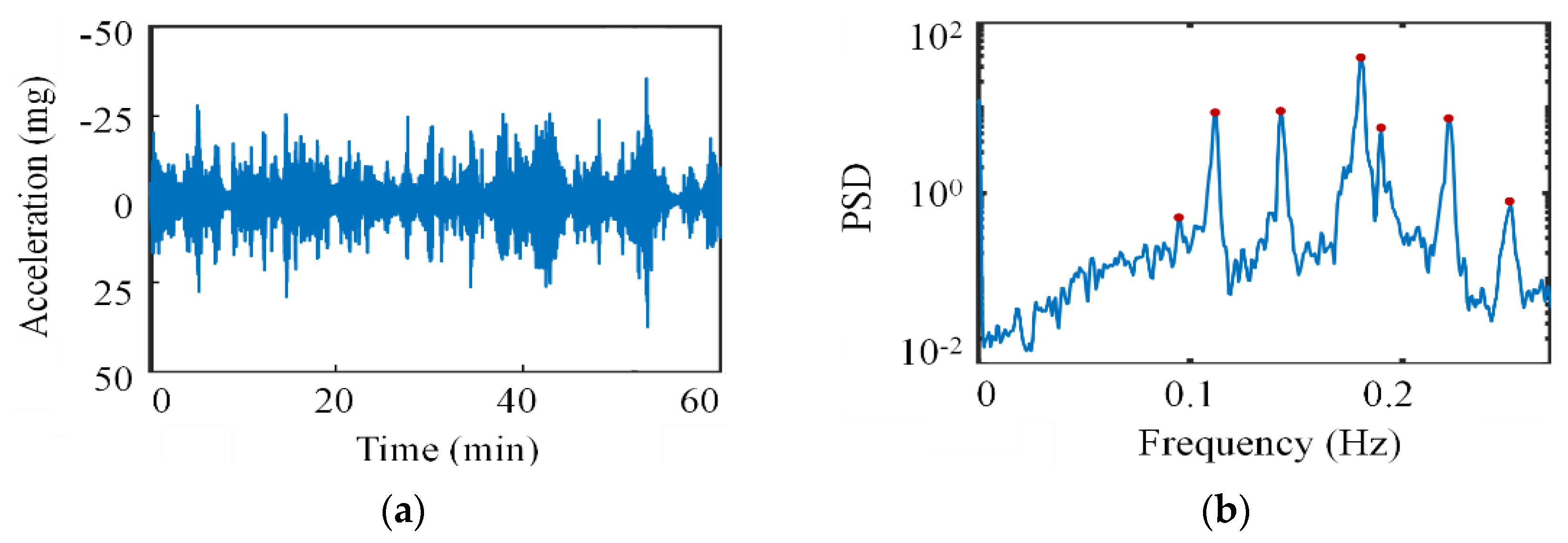1. Introduction
Modern suspension bridges are typically the preferred choice for extremely long-span bridges due to their lightweight nature and exceptional spanning capacity. Due to advances in computational theories, high-performance composites, computer technology and construction methods, the spans of suspension bridges are continuously expanding [
1,
2]. The 1915 Çanakkale Bridge in Turkey holds the record for being the longest suspension bridge ever constructed, boasting a main span of 2023 m [
3]. The Zhangjinggao Yangtze River Bridge in China, with a span of 2300 m, is currently the largest suspension bridge under construction globally [
4]. There is no doubt that the tensile strength of the main cables of suspension bridges under self-weight or initial tension is the primary factor determining the continuous expansion of the main span [
5].
In essence, the gravity stiffness comes from the geometric nonlinearity, which depends heavily on the configuration and internal forces of the main cable. Nonlinear geometrical behavior occurs due to second-order effects from normal forces and external loads as the main cable undergoes large displacements. In addition to the need to develop a nonlinear relationship between forces and displacements, obtaining the initial geometric configuration is a difficult task since a large number of variables need to be identified [
6,
7]. Many studies have focused on this subject [
8]. At present, the methodology for determining the shape of the main cable can be broadly divided into analytical-based methods and finite element modeling (FEM)-based methods. The analysis method is generally based on the segmented parabolic theory and segmented catenary method (SCM) [
9,
10,
11,
12]. The configuration of the main cables in the completed bridge state is first calculated and then evaluated during the construction phase according to the principle of equal lengths of stress-free cables. The segmented parabolic theory assumes that the shape of the main cable is parabolic under a uniform load, and this approximation ignores the concentrated forces transmitted by the suspenders [
5,
13].
The application of large-scale integrated finite element analysis programs has made it possible to analyze structures of various spans and forms. Scholars have developed various shape-finding methods for the main cables of suspension bridges, such as the Targeted Configuration Under Dead Load (TCUD) method [
14], the modified TCUD method [
15], the generalized TCUD method [
16], the coordinate iteration method [
17] and the perturbation method [
18]. In these methods, the unstrained length of each main cable segment is unknown and is solved in continuous nonlinear equations using nonlinear finite element iterations. Related research has been carried out in recent years, focusing on the optimization and careful analysis of these calculation methods [
19,
20,
21,
22]. Zhang et al. [
23] proposed an analytical algorithm to estimate the effect of thermal effects on the shape of the main cable, taking into account the tower saddle–arc effect as well as the combined cable–hanger–girder effect. Wang et al. [
24] presented an analytical calculation method considering the combined effect of a main cable–vibration damper–girder. Shin et al. [
25] developed a deflection theory for ground-anchored suspension bridges with manufactured convexity by considering the tower effect and the large deflection effect of the main cables. These theoretical derivations are computationally intensive, and the implementation of the algorithms requires a high level of programming skills. Moreover, many of the special elements are not widely embedded in the analysis software commonly used in current engineering, which greatly limits the application of general-purpose analysis software to typical engineering problems [
5,
9,
26].
In the absence of theoretical derivation and original programming, it is more practical for the normal bridge engineer to use it directly for general engineering analysis based on the general bridge analysis software developed for determining the reasonable state of suspension bridges with spatial cables [
9,
26,
27,
28]. Zhang et al. [
9] proposed a finite element method for shape-finding and force assessment of suspension bridges based on completed loop adjustment. Xiao et al. [
26] considered the coupling of spatial main cables and hangers, proposing a five-step algorithm without theoretical derivation and primitive planning to determine the reasonable state of spatial cable of suspension bridges. Sun et al. [
17] established a four-step methodology for determining a reasonable completed bridge state, focusing on optimizing the tension and shape of all the cables and independently analyzing the nonlinear effects of each load at the service condition. These methods are not universal, and the modeling accuracy for suspension bridges with special elements needs further consideration. In the case of the Nanjing Qixiashan Yangtze River Bridge, the displacement-limiting suspenders were set up at the side spans near the anchorages, with their lower ends anchored to the transition piers. This makes the reasonable completed bridge state of the suspension bridge different from that of normal suspension bridges. Therefore, it is necessary to propose a refined modeling and main cable shape-finding method for suspension bridges with such special elements.
Based on this research background, this paper proposes a relatively clear nonlinear finite element modeling method, which is mainly carried out by the commercial FE software ANSYS 2022 R1, to provide an optimal solution for the target configuration of a similar suspension bridge. In the proposed method, all the components are included, and the pre-arching of the main cable and pylons is assumed to be adjustable. Firstly, based on the asymptotic criterion and temperature correction, the shape-finding and force assessment of the main cables are carried out. On this basis, the model was calibrated by taking into account factors such as pylon settlement and cable saddle precession. Finally, the static and dynamic characteristics of the suspension bridge were thoroughly investigated by taking the Nanjing Qixiashan Yangtze River Bridge as an example.
2. Main Cable Shape-Finding and Modeling Approach
2.1. Iterative Calculation of Tension Force and Shape of the Main Cable in the Mid Span
Determining the reasonable state of the mid-span main cable is the most critical step in the algorithm. The mid-span main cable has a well-defined rise-to-span ratio, and the general idea of shape-finding is to solve for stress-free shapes that satisfy the geometric convergence objective under bridge loading. With the powerful geometric nonlinearity function of Ansys, this module is based on the loop adjustment, and the flow chart is shown in
Figure 1. The main cables are usually assumed to be flexible rods subjected to tension only. Two endpoints and a center point are used to control the shape, which does not change with the nonlinear iterative process. Then, longitudinal displacement constraints are added at the two endpoints, and the remaining nodes can be modeled initially based on parabolic or catenary curve interpolation. The self-weight of the suspenders, the weight of the cable clamps and the tension of the suspenders are applied as a concentrated load on the IP points of the main cable. The initial strains of the elements are given by Δ/
l, where Δ is the difference between the length of the element,
l, and the length of the zero strain. The initial strain reflects the internal stresses of the element at the modeled length, as shown in Equation (1).
where
ε0 is the initial strain,
σ0 is the internal stress of the element under the modeling length and
N0 is the internal axial force of the element under the modeling length.
For the dynamic correction factor
β, which combines the target state and the iterative process, it is calculated according to the following equation.
where
is the difference between the resultant y-coordinate of this iteration and the design y-coordinate of the center point,
is the displacement of the center point of this iteration and the initial
β needs to be preset, which can be taken as 0.02 based on experience.
After the correction factor is updated, the main cable strain (axial force) needs to be updated accordingly. This ensures that the initial strain correction is larger when the current structure is far from the target state and smaller the closer it is to the target state, which, in turn, leads to faster convergence. Then, return and rerun the nonlinear iteration until the x and y displacement values satisfy the convergence criterion, i.e., less than 0.01 mm, at which point the mid-span shape-finding is completed. The suspender force participates in the overall cycle as one of the discriminating criteria. Subsequent application of the suspender force is taken from the data parameter file corrected. The mid-span shape-finding is used to obtain the stress-free line shape corresponding to the completed bridge state, which also includes the position information of the corresponding cable clamps. The output horizontal force of the main cable is used for side-span main cable shape-finding as a discriminating condition for the equal horizontal force of side-span and mid-span main cables in the completed bridge state. The output vertical force at the IP points is used for the vertical pre-throw height of the pylons to ensure that the position of the saddle meets the error requirements of the bridge criterion.
2.2. Iterative Calculation of Tension Force and Shape of the Main Cable in the Side Span
The side-span main cables do not have a predicted rise relative to the mid span, but there is a definite horizontal force of the main cables on the basis of the mid-span shape-finding. The fundamental objective of shape-finding for the side span is to solve the stress-free length so that it can meet the equilibrium conditions with the mid-span cable under the bridge load and, at the same time, meet the geometric convergence target. The general idea of a stress-free length solution in this study is to iteratively search for temperature corrections to satisfy the convergence criteria. The change in length of the main cable following a change in temperature can be calculated using the linear thermal expansion equation:
where Δ
L is the length change,
α is the coefficient of linear expansion of the main cable,
L0 is the original length and Δ
T is the temperature change.
The apparent stress-free state of the main cable at the side span is the initial configuration of the model or the corrected model after the procedural solution; however, this does not reflect the true stress-free length, which contains temperature corrections to satisfy the convergence criterion. The temperature is a correction value introduced by the programmed simulation of the unstressed length, which does not exist in the real situation. For the side span, the unstressed length accounted for by the procedure is objectively increased, and the gravity of the structure is increased accordingly. Therefore, the density of the main cable is corrected according to the principle of quality conservation based on the temperature correction value to ensure the high accuracy of the calculation results. The flowchart for shape-finding and force-finding for side-span main cables is shown in
Figure 2.
When the main program calls the module for shape-finding of side-span, the temperature-limit values, i.e., Tmin and Tmax in the flowchart, need to be attached to improve the efficiency of the search. The values are related to the initial conformation and temperature sensitivity of the main cables, which are difficult to grasp accurately during the model construction process. Excessive limits will increase the number of cycles, so a cycling function that automatically adjusts the temperature limit is also added to the module. In addition, the nonlinear iterative process of the side span proposed in this paper essentially simulates the true unstressed length through additional temperature corrections, and the initial conformation of the main cable cannot be adjusted. The model correction is only an adjustment of the cable clamp nodes along the initial configuration to meet the geometric accuracy requirement of 0.01 mm.
Theoretically, the initial configuration can be established according to a straight line. For the three-span continuous suspension bridge, the side-span vectors are obvious. The straight-line initial configuration increases the difficulty of convergence to some extent, and the initial configuration can be performed according to a parabola close to the actual vector. The search is performed based on the dichotomy method for expression of the temperature, which is not economical and has a slow convergence rate. The incremental linear interpolation-based method rapidly approaches the target temperature and is extremely fast to solve.
2.3. Iterative Calculation of Tension Force and Shape of the Main Cable in the Anchorage Span
In this subsection, only the anchor span and the cable saddle are considered, and an accurate shape-finding is performed for the anchor span. The Spar (or Truss) unit is used to simulate the saddle, and a very large modulus of elasticity is preset to simulate the very high compressive stiffness of the saddle. The general idea of anchor span shape-finding is similar to that of side span, which is to simulate the real stress-free length based on the apparent stress-free model with additional temperature correction. To satisfy the equilibrium condition for a three-span continuous suspension bridge under dead load, the horizontal component of the main cable force in the two anchor spans is equal to that in the side spans. By defining the initial main cable shape in the anchor span as a straight line, the balanced shape can be obtained in the same way as for the side spans. The problem is solved according to the flowchart shown in
Figure 2.
After the implementation of the above procedure in a three-span continuous suspension bridge, preliminary main cable shape-finding was achieved. The coordinates and strains, stress-free lengths and forces within the finite element model were extracted from the last modeling of the end of the loop. However, an overall finite element model of the whole bridge still needs to be constructed as the model has been constructed to take into account the effects of each individual member and has been significantly simplified for the pylons and saddles. Previous results will be imported to verify the accuracy of the main cable shape-finding.
